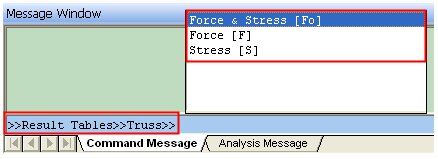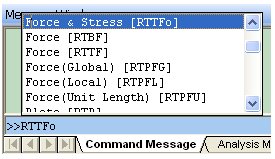Command Line
To avoid the process of clicking several times for invoking a function, midas has incorporated a new feature known as "Command Line". This feature is similar to the one in AutoCAD and improves the efficiency of modeling and analysis. By just typing a simple abbreviated command in the Command Line, the program will invoke the dialog box or direct the user to the related function. This will speed up the process of generating an analytical model and improve its accuracy in design.
The shortcut commands for the Command Line are saved in a shortcutkey. cmd file in a text format, which is located in the User Folder. For generating a frequently used command, the user can create or modify commands in this text file.

Command Line
How to use the Command Line
1. Click on the Command Line or click on an arbitrary point in Model View and then Press the Space Bar. The user will then see the cursor blinking on the command line.
2. Enter a shortcut key that is indicated in the shortcutkey. cmd file. There are two kinds of keys that can be specified - the Command Key and the Group Key. Command Key is the key for invoking any menu or function. Group Key is the key for invoking a Command Group. If all menus of midas Civil need to be defined then there will be some difficulty in defining shortcuts with one or two characters. Also, if the number of characters is increased, then the efficiency of using the shortcut keys will decrease. For this reason, midas has introduced the tree structure of folders which is similar to the one in Microsoft Windows. Several keys can be grouped together and the same command in another group can be specified to be the same key. The shortcut key does not need to be designated in a specific group and several groups can exist in one group.
[Examples]
1) Using the Command Key:
By inputting 'PM' in the command line 'Properties > Material Properties' menu can be invoked.
2) Using the Group Key:
Since, 'P' represents a group key for 'Properties' and 'M' represents a command key for 'Material' typing 'PM' will invoke the material properties dialog box. Another option is to type the characters separately. If 'P' is typed then the program will invoke the Properties group and a pop-up list will appear showing the commands that can be chosen. If 'M' is typed, then the program will invoke the Material properties dialog box, which is the same as typing 'PM'

Shortcut Keys input using the Command Line
3. When any character is inputted in the Command Line a pop-up list containing the sub-commands appears. The user can either type the command as specified by the character, or use the direction keys to highlight the command and select it by either pressing the space bar or Enter key. The user can also select by clicking the command with the mouse.
4. After the command is executed, the Command Line reverts back to the default state.
5. The user can delete the inputted command by pressing the backspace key.
How to create a Command Key
All the information relating to the Command Keys is saved in a shortcutkey.cmd file which is located in C:\> Program Files> MIDAS> MIDAS Civil> User folder. By modifying this file the user can customize the shortcut keys for frequently used commands.
The format of the shortcutkey.cmd file is as follows. Usually one command key and one Group Key are included in one line.
Key, Display Text/Group Path, Type, Menu Path or Group Name/Path

Key: Shortcut Key to invoke the applicable dialog box.
Display Text: The text that is displayed when inputting the corresponding key.
Group Path: If the corresponding command key is a key inside a group, then the user inputs the Group path. When inputting the Group path, the user should use the name of the group.
Type: Type of Keys
C: Command Key.
G: Group Key. Selects the Command Group
L: Selects the lower grade group. This is a shortcut key to select other groups that are included in the group which is active.
Menu Path: If the Key type is 'C' then the user should define the path of the menu to be performed. The path should be inputted based on Main Menu and '...' included in the menu is ignored. Writing with upper case or lower case doesn't matter.
Group Name: If the Key Type is 'G' then the user inputs the name of the group.
Group Path: If the Key type is 'L' then the user inputs the path of the upper graded group which the selected lower grade group is included. When inputting the path of the Group the user should use the name of the group.
[Example]
1. RT, Result Tables, G, RT
2. T, RT > Truss, G, RTT
3. RTT, Truss, L, RT > Truss
4. Fo, RT > RTT > Force & Stress, C, Results > Result Tables > Truss > Force & Stress
5. RTTF, Force, C, Results > Result Tables > Truss > Force
1. This creates a Command Group of 'RT' When the user types 'RT' on the Command Line then a pop-up list will appear and the Result Table will be selected. The lower grade group pop-up list will also be displayed.

2. This defines a group name 'RTT' which is a lower grade of 'RT" and the group key as 'T' is specified. In this case, in the path 'RT > Truss', 'RT' does not refer to a Group Key but is a Group name.
The user selects the Result table by typing 'RT' and the Truss Group by typing 'T' again. Then a pop-up list of Command Keys which is included to the Truss Group will display.

3. This defines a 'L' type key 'RTT' which is included in Result Table (RT). This key enables the user to select the Truss Group at once. If the user types 'RTT' then the group path of RT>truss can be selected.

4. This defines the command key 'Fo' This is a command key for the Force and Stress menu which is a lower grade group of Truss. The command key 'Fo' which performs the path 'Results > Result Tables > Truss > Force & Stress'. should be defined in the group of Result Table (RT) > Truss(T).
To perform this key, the user should assign the key in the 'Result Table (RT)>Truss' group.

5. This defines a Command Key 'RTTFo'. which performs the path 'Results > Result Tables > Truss > Force & Stress'. Since this Command Key is not included in any Group, it can be typed in the default Command Line.

Note 1
1. If there are group keys that are duplicated, then the program will read the upper Group that is defined in the shortcutkey.cmd file.
2. If the Command Key is duplicated, then the program will read the latest Command that is defined in the shortcutkey.cmd file.
3. The user should specify the Group Name precisely to designate the path of the Group.
4. The user can press the space bar when the Command Line is defaulted to display the keys included in the Upper Groups or Command Keys that are not included.
5. The user cannot use the Command Line function during analysis.